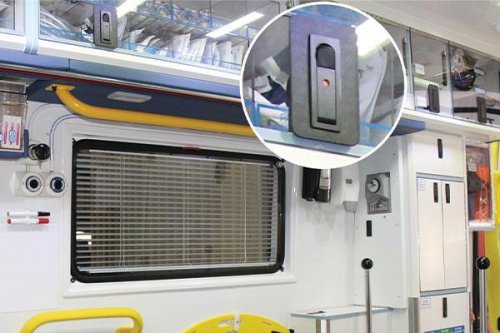
Consumer and end-user expectations around the efficient, reliable and cost-effective securing of products and equipment have rapidly increased in recent years. Equipment manufacturers increasingly face challenges in protecting valuable, sensitive equipment against failure, human error and unauthorized access, as well as growing cyberattack threats.

Consumer and end-user expectations around the efficient, reliable and cost-effective securing of products and equipment have rapidly increased in recent years. Equipment manufacturers increasingly face challenges in protecting valuable, sensitive equipment against failure, human error and unauthorized access, as well as growing cyberattack threats.
At the same time, the act of physically securing vital assets and fixtures needs to be kept cost-effective, low-maintenance, and easy to integrate and operate. Security and safety measures that are overly complex can undermine the effort to establish strong security in the first place.
Balancing ease of operation and cost, with effective safety and security, presents a significant opportunity for innovative designers — there are simple, robust and proven devices that industrial designers can consider that often provide useful, intuitive solutions to these challenges.
The power of visual indication
One of the simplest and yet most effective ways to ensure that equipment enclosures and panels are, in fact, secure is through visual indication — features engineered into devices that give the user obvious, immediately visible information about whether a door or access panel is properly, safely and completely secured.
Leading component suppliers are now offering both mechanical and electromechanical locks and latching mechanisms that incorporate a range of visual safety and security indication functions. Providing a range of visual indicators makes it easier for design engineers to select and integrate the technology that meets all their functional requirements, supports operator efficiency and contributes to error-proofing safety and security.
In the environments where we live and work, there is a constant stream of visual information related to safety and security. In our cars, if we attempt to drive without buckling up or if a passenger door or tailgate isn’t fully secured, we receive visual information alerting us to the risk through highly visible graphics or audio signals.
In warehouses, factories and construction sites, prominent signage with easy-to-read, color-coded visuals alerts people to the need for hard hats or the presence of high voltage equipment, or points to emergency alarms and exits.
Securing valuable infrastructure
Throughout our built environment, there are equipment enclosures, storage units and valuable or sensitive units with access panels and doors that must be properly latched and secured on a routine basis.
These range from large light fixtures in office spaces, public lobbies and commercial settings to telecommunications network equipment and ATMs that people interact with every day. These types of enclosures are also in more securely controlled facilities, such as server cabinets in data centers or cages and enclosures for automated manufacturing systems on factory floors.
Each type of enclosure presents different risk factors if not properly secured:
• Public safety: If a panel covering a fluorescent or LED light fixture isn’t sealed, or an exterior door covering equipment on a trolley or train isn’t completely closed, it can fall open or off and potentially create a hazardous situation.
• Environmental safety: Outdoor lighting fixtures and utility enclosures that aren’t completely secured after servicing could allow rain and ice to infiltrate the enclosure and damage valuable equipment.
• Operator safety: Machine enclosures that aren’t fully secured after manufacturing systems or machine tools have been serviced are typically tied to safety interlocks, preventing restarts; with proper visual indicators showing that doors and hatches are fully closed, operators can restart machines without delay.
• Cyber safety: Systems that interact with computer networks, such as servers in data centers as well as network equipment and wireless cell sites, are targets for both vandalism and hackers seeking to steal sensitive personal and corporate data.
Selecting the right safety indicator solution
There are a range of latching and locking systems with visible indicators that can be chosen to provide the appropriate level of safety and security for these different applications. Selecting a latching system with integrated visual indication can enhance safety, reduce maintenance errors and also help increase operational efficiency.
Keeping panels secure with visual indication
Certain applications require a more advanced form of visible indication be built into the locking and latching mechanism for enhanced security. These applications, such as high-end vending machines, lottery kiosks and ATMs, typically require more frequent access for restocking and maintenance.
Locking mechanisms on these machines benefit from having clear and easy-to-see visual indicators that let the end user know whether the machine or enclosure has been accessed, thereby identifying what compartments need to be replenished or serviced.
A compression latch designed with a spring-loaded metal cap that pops open, and cannot be closed as long as the latch is open for instance, requires the user or technician to actively make certain the latch has been secured in order to return the cap to its normal position.
There are economical compression latches that incorporate simple, color-coded features designed to be visible whenever the latch is in the open or unlatched position. For example, a latch designed with brightly colored, highly reflective wings that pop out on either side of the latch when it is open, allow it to be clearly noticed during the day or at night. This type of latch is well-suited for lighting fixtures, storage compartments in public areas or exterior panels on mass transportation, construction or agricultural vehicles where it is important to verify whether a panel is unsecured.
Monitoring panel access through visual indication
Certain lever latches can be designed with a small, color-coded window that indicates latch status as well. When the window is green, it indicates that the latch has not been opened since it was last reset. When the latch is opened, the indicator changes from green to red, and cannot be returned to green until the latch is securely closed using a special mechanical key. This can be very useful for ambulances, where it is standard practice to restock all of the internal storage compartments as quickly as possible after a run. Rather than having to open and check every storage compartment to see if it needs restocking, maintenance staff can quickly identify and re-stock only those that have been accessed, reducing the time the ambulance is out of service.
This design is based on a simple modification to a proven, standard design and provides an important advantage for industrial designers: visible safety can be added to existing access panel designs without having to redesign the system or change the panel preparation to accommodate different latching dimensions or requirements. This simplifies the process of adding a safety and security feature, without major cost impacts.
Controlling panel access through digital audit trail
There are a range of electromechanical latching systems offering enhanced and sophisticated solutions for viewing secure status, and tracking when and how an enclosure has been accessed.
For applications such as server cabinet doors in data centers or 5G cell site enclosures, there are advantages to implementing full-featured electronic access solutions (EAS) to physically protect highly valuable equipment and closely track when, who and for how long those vital systems are accessed.
An electronic access system typically features three primary components: an access control or input device, an electromechanical lock and a system for monitoring the status of the access point. EAS platforms offer a range of access devices including RFID card readers, key fobs with proximity sensors or numeric keypads built into the lock into which a PIN code is entered.
The most secure access credential — which is gaining widespread use — supplies an electronic, time-based key via a mobile app on a technician’s smartphone. The electromechanical latch has a Bluetooth reader, allowing the technician to access the cabinet or enclosure using their electronic key via a secure Bluetooth connection. A digital audit trail is established to document enclosure access and is stored in the cloud.
Many electronic locks and access controllers typically incorporate red and green lights to visually indicate whether the lock is secured or unsecured; this can help remind the technician to properly secure the door or access panel after the work is done.
Working with proven suppliers
Design engineers have a range of latching options that incorporate visible safety indicators available to them, with many relatively low-cost solutions that act as drop-in replacements for standard parts. It’s important for enclosure designers to determine whether this type of visible indication is required prior to completing the overall design. This helps prevent quality control or safety engineers from identifying a need for a replacement or redesign later in the project timeline.
Design engineers can ensure they are choosing the right visible indicator for their application by consulting with experienced suppliers of locking and latching systems early on in the design process. By understanding the safety and security requirements of the enclosure, panel or storage compartment design upfront, proven suppliers can deliver solutions that leverage the value of visible safety indicators to improve the overall functionality of the final design.
